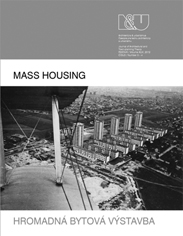THE RESIDENCE AS A DECISIVE FACTOR: MODERN HOUSING IN THE CENTRAL ZONE OF NEW BELGRADE
THE RESIDENCE AS A DECISIVE FACTOR: MODERN HOUSING IN THE CENTRAL ZONE OF NEW BELGRADE
Author(s): Ljiljana BlagojevićSubject(s): Cultural Essay, Political Essay, Societal Essay
Published by: Historický ústav SAV, v. v. i.
Summary/Abstract: The article presents, documents, and analyzes the housing mega-blocks in the centre of New Belgrade (Serbia). Constructed in the socialist period, the blocks form the core of the new modern city and provide housing for some 50,000 inhabitants. In the six decades since its inception, this complex of modernist mass housing constructed on the marshy alluvial plain circumscribed by the rivers Sava and Danube, between the two independently developed historical cities of Zemun and Belgrade, evolved into an integrative modern urban structure of the Greater Belgrade metropolis. I propose that it presents a striking example, as well as support for the thesis quoted in the epigraph by Manfredo Tafuri and Francesco Dal Co regarding socialist city planning. The housing in the centre of New Belgrade acts as a decisive factor in the urban planning and expansion of metropolitan Belgrade. The blocks in question are thus more than an assemblage of mass housing: they form the core of the modern city in the heart of the metropolis, and as such they are at the centre of contemporary post-socialist transformations. The paper discusses the original six housing blocks which were constructed in the 1960s and 1970s closely following the composition and urban planning parameters set in the unifying Plan of New Belgrade’s Central Zone (1960). In all of the blocks, the residential buildings and associated social services programs, that is, community centres, schools and kindergartens, as well as playgrounds, open green and recreational spaces, were designed by prominent architects of the period on the basis of their winning entries in architectural competitions. The housing architecture demonstrates a shift in the design values from the white geometric abstraction of the early period to a new brutalism of exposed concrete and prefabaesthetic of the 1970s and, even later, the emerging postmodernist forms of late socialism. The planning, design and construction of public housing in the socialist period, with an average of 10,000 new apartments built in Belgrade each year, complemented the ideological construct of self-management. The socio-political meaning of self-management, based on two fundamental components (functional and territorial), was given spatial meaning when directly translated into housing communities as basic territorial units with a degree of autonomous political function. The planning and design of housing aimed to address diverse aspects and issues, such as : –– urban planning concept of housing communities, that is, local communities, –– industrialization of housing construction, –– dwelling use value (analysis of needs and evaluation of apartment usability), –– identity and flexibility vs. unification, serialization and monotony, –– sociology of habitation, –– psychological aspects of experiencing greenwith 10,000 inhabitants in urban blocks measuring 600 m by 400 m, and two smaller ones of 4,000 inhabitants each in two blocks measuring 400 m b
Journal: Architektúra & Urbanizmus
- Issue Year: 46/2012
- Issue No: 3-4
- Page Range: 228 - 249
- Page Count: 22
- Language: English

